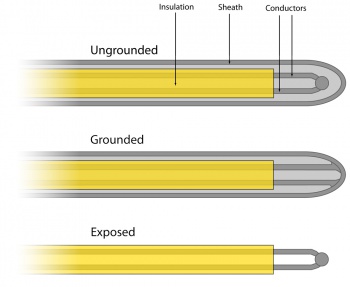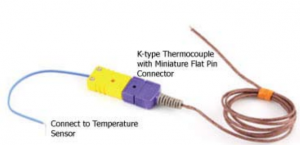Thermocouple Guide
Introduction
A thermocouple is a device consisting of 2 different conductors that produce a voltage proportional to a temperature difference between either end of the pair of conductors. There are many types of thermocouples, with varying types of conductors and probe designs.
Most thermocouples produce voltages of less than 50mV so very sensitive electronics are required to interface with them.
Choosing a Thermocouple
Conductor Calibration Types
J, K, E and T-Type thermocouples are the most common types of thermocouples. Each type has a different temperature range and resolution due to the metals used in the conductors.
| Type | Temperature Range °C | Notes |
|---|---|---|
| K | -200 to +1250 | The most common sensor, wide range, good in oxidizing atmosphere |
| J | 0 to +750 | More Limited range, main application is with old equipment that cannot accept modern thermocouples |
| T | -200 to +300 | Most Accurate base-metal thermocouple, non-magnetic, popular choice for strong magnetic fields and subzero environments |
| E | -200 to +900 | Well suited to low temperature (cryogenic) use |
The insulation that surrounds the thermocouple is the limiting factor in the true temperature range. For example, a K-type thermocouple insulated with teflon is good up to +200°C. The same thermocouple using Fiberglass is good to 480°C. For short durations the thermocouples can be exposed to higher heat than they are rated for, however, they will degrade if exposed to very high heat for long periods of time.
Using Other Thermocouple Types with Phidgets
You can interface with other thermocouple types using Phidgets Inc. thermocouple interfaces, with some minor calculations:
- First, visit this website and open the conversion table for the desired thermocouple type.
- Take the ambient temperature value measured by the board and use the ones digit to select the column, and the other digits to select the row. Record this thermoelectric voltage value.
- Use the getPotential call in your program in order to get the thermocouple's current thermoelectric voltage value.
- Add the two voltage values from the previous steps and use the table to convert back into temperature.
Junction Type

An important feature to consider when choosing a thermocouple is the junction type. This describes the degree to which the sensing end of the thermocouple is exposed to the environment it's measuring. There are three main types of junctions: Grounded, Ungrounded, and Exposed.
Ungrounded
A thermocouple with an ungrounded junction has a metallic outer sheath, usually made of a corrosion-resistant material such as stainless steel. The junction where the two conductors meet is suspended inside this sheath, such that the end of the junction is not in contact with the sheath. As a result, it will take longer for the thermocouple to react to temperature changes in the environment, because the inside of the sheath must reach thermal equilibrium before the conductors can detect the change. Ungrounded thermocouples can be used with a Phidgets Inc. thermocouple interface with no issues as long as the type is also supported.
Advantages:
- The conductors are protected from the environment, enabling the sensor to be used in a wider range of applications.
- Since the conductors are not grounded, the thermocouple will not introduce a ground loop into the system.
Disadvantages:
- It takes longer for the thermocouple to react to temperature changes in the environment because it is not in direct contact with it.
Grounded
A thermocouple with a grounded junction has an outer sheath just like the ungrounded design, but the junction where the two conductors meet is welded to the inside of the sheath. This allows for a shorter reaction time to temperature changes, but is likely to introduce a ground loop into the system. In order to use a grounded thermocouple with a Phidgets Inc. thermocouple interface, you need a USB isolator to ensure system stability.
Advantages:
- The conductors are protected from the environment, enabling the sensor to be used in a wider range of applications.
- Reacts more quickly to temperature changes in the environment.
Disadvantages:
- Special care must be taken to protect your system's stability from ground loops.
Exposed
A thermocouple with an exposed junction has no protective sheath, allowing the junction where the two conductors meet to be in direct contact with the environment it's measuring. As a result, an exposed thermocouple will have the fastest reaction time, but can only be used in non-corrosive, non-pressurized applications (While it is possible to use exposed thermocouples in high pressure applications, it is difficult to make a proper seal. Many enclosed thermocouples will have special hardware for this sort of application). Exposed thermocouples can be used with a Phidgets Inc. thermocouple interface with no issues as long as the type is also supported.
Advantages:
- Exhibits the fastest reaction to temperature changes in the environment due to direct contact.
- Since the conductors are not grounded, the thermocouple will not introduce a ground loop into the system.
Disadvantages:
- Limited to non-corrosive, non-pressurized applications.
- The thermocouple has no protection from physical contact.
Things to Watch For
Electrical Interference
When measuring from a thermocouple, each thermocouple is compared to adapter's internal ground. If your thermocouple is measuring a conductive device which cannot equalize to the ground of the adapter, you should isolate the thermocouple wire using thermally conductive epoxy. Thermocouples are conductive, and are very good at shorting electrical systems together. If in doubt, do not allow the thermocouple wire to contact other metal parts.
Wire Size
The maximum temperature varies with the diameter of the wire used in the thermocouple. Although the type of thermocouple dictates the temperature range, the maximum range is also limited by the diameter of the thermocouple wire. That is, a very thin thermocouple may not reach the full temperature range. On the other hand, a thinner thermocouple does reduce the amount of thermal distortion introduced.
Selecting the wire size used in the thermocouple sensor depends upon your application. Generally, when longer life is required for the higher temperatures, the larger size wires should be chosen. When sensitivity is the prime concern, the smaller sizes should be used.
Wire Length
Very long thermocouples are okay (even 100m), but if there is measurement stability issues or USB resets, ferrite beads can be added to the thermocouple wire close to the adapter. See our tutorial on Addressing EMI issues.
Note that thermocouples use special wires. This means that if you want to extend the length of your thermocouple you need to use thermocouple wire not generic wire.
How to connect your Thermocouple
Stripped Wire
Most thermocouples come with the leads just stripped and otherwise unaltered. We recommend a 5 to 6mm wire strip length; the terminal blocks on the majority of adapters will accept wires between 16 - 26 AWG. When using thin wires, make sure that you have a solid connection after tightening the terminal screw.
Connectors
Many K-Type thermocouples are designed to mate with the Subminiature (flat pin) female connector. Listed below are examples of compatible thermocouples from popular sensor manufacturers using this connector.
| Manufacturer | Part Number | Description |
|---|---|---|
| Omega | TC-PVC-K-24-180 | PVC-insulated 4.5m epoxy-coated tip k-type |
| Omega | 88202K | Moving-surface swivel-head handle k-type |
| Omega | 88402K | Flat-leaf magnetized k-type |
| Nanmac | B8-10 | Handheld trident-style ribbon k-type |
| Cole-Parmer | WU-93631-11 | ICONEL-sheathed high-temp 12” k-type |

